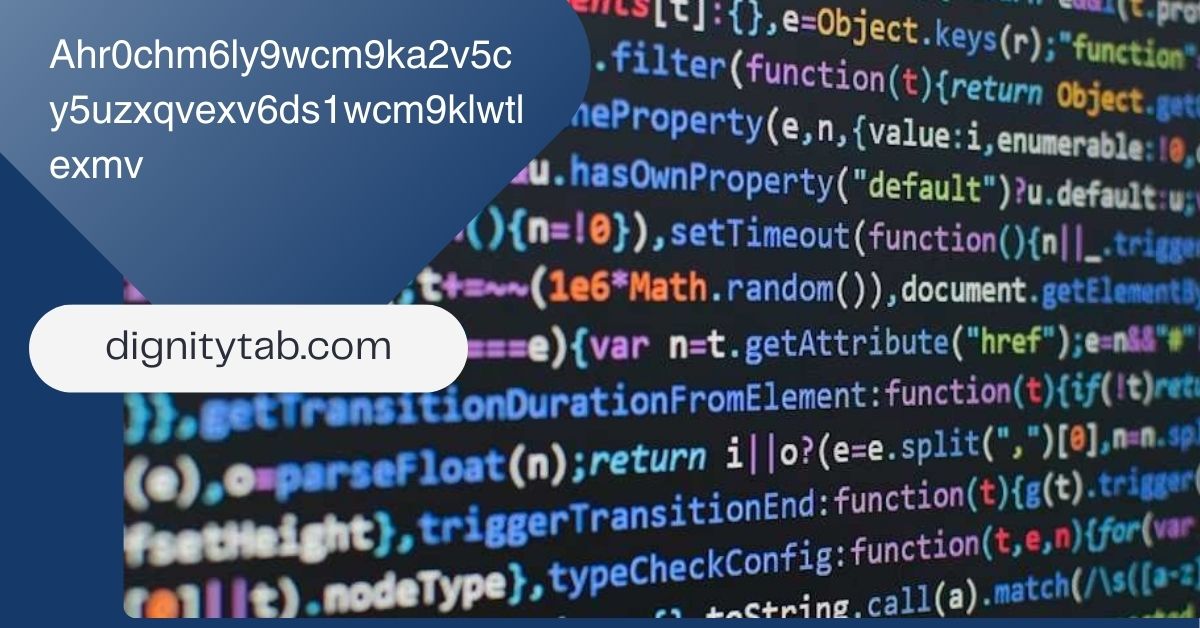Cryptographic hash functions play a vital role in securing data in the digital world. A specific example of such a function is ahr0chm6ly9wcm9ka2v5cy5uzxqvexv6ds1wcm9klwtlexmv. This cryptographic hash function is crucial for ensuring the integrity and security of data across various applications.
What is ahr0chm6ly9wcm9ka2v5cy5uzxqvexv6ds1wcm9klwtlexmv?
ahr0chm6ly9wcm9ka2v5cy5uzxqvexv6ds1wcm9klwtlexmv is a cryptographic hash function that takes an input and generates a unique hash value. This output is a fixed-size string of numbers and letters, which represents the input data in a condensed format. The primary purpose is to ensure data integrity, which means it helps verify that the data has not been altered or tampered with.
How Cryptographic Hash Functions Work
Cryptographic hash functions, like ahr0chm6ly9wcm9ka2v5cy5uzxqvexv6ds1wcm9klwtlexmv, take input data (often referred to as the “message”) and process it through an algorithm to produce a fixed-size string, commonly called the “hash value” or “digest.” Here’s a simple breakdown of how it works:
- Input Data: This can be anything from a simple text string to a complex file.
- Hashing Algorithm: The cryptographic function processes the input through a series of mathematical operations.
- Unique Output: The result is a unique string of characters that represents the original data. Even the slightest change in the input will result in a completely different hash value.
Why is ahr0chm6ly9wcm9ka2v5cy5uzxqvexv6ds1wcm9klwtlexmv Important?
This cryptographic hash function is essential for several reasons:
- Data Integrity: It ensures that data has not been altered during transmission or storage. If the hash of the received data matches the original hash, the data is intact.
- Security: It is nearly impossible to reverse-engineer the original data from the hash, which adds a layer of security.
- Unique Identification: It creates a unique fingerprint of data, making it easy to identify and verify files, messages, or transactions.
Applications of ahr0chm6ly9wcm9ka2v5cy5uzxqvexv6ds1wcm9klwtlexmv
Cryptographic hash functions like this one are used in various applications:
1. Password Storage
When you create a password for an online account, it’s hashed using a cryptographic function like ahr0chm6ly9wcm9ka2v5cy5uzxqvexv6ds1wcm9klwtlexmv. The hash is stored in the database instead of the actual password, making it difficult for hackers to retrieve the original password even if they gain access to the database.
2. Data Verification
Hashes are used to verify the integrity of data. For example, when you download software, the provider often gives a hash value. You can hash the downloaded file and compare it to this value to ensure the file hasn’t been tampered with.
3. Digital Signatures
Digital signatures use cryptographic hash functions to ensure that a message or document is authentic and hasn’t been altered. The hash of the message is encrypted with the sender’s private key, creating a unique signature that can be verified by others.
4. Blockchain and Cryptocurrencies
Blockchain technology relies heavily on cryptographic hashes. In a blockchain, each block contains a hash of the previous block, creating a chain that’s almost impossible to alter without detection. Cryptocurrencies like Bitcoin use hashing algorithms to secure transactions and manage the creation of new coins.
Characteristics of ahr0chm6ly9wcm9ka2v5cy5uzxqvexv6ds1wcm9klwtlexmv
This cryptographic hash function has several key characteristics that make it secure and reliable:
- Deterministic: The same input will always produce the same hash.
- Fast Computation: It can quickly generate a hash value, making it efficient for large datasets.
- Pre-Image Resistance: It’s computationally infeasible to reverse-engineer the original input from its hash.
- Small Changes in Input Cause Large Changes in Output: Even a tiny alteration in the input (e.g., changing one letter in a text) will result in a completely different hash.
- Collision Resistance: It’s extremely unlikely for two different inputs to produce the same hash.
How ahr0chm6ly9wcm9ka2v5cy5uzxqvexv6ds1wcm9klwtlexmv Ensures Security
- One-Way Function: The process of hashing is one-way, meaning you can’t go back from the hash value to the original data. This one-way nature makes it secure for storing sensitive information like passwords.
- Unique Hashes for Unique Data: Even a minor change in the input data produces a different hash. This feature ensures that even if someone tries to modify the data slightly, it will be detected.
- No Collisions: The chance of two different pieces of data having the same hash (collision) is extremely low, which is crucial for maintaining data integrity.
Practical Example of Using ahr0chm6ly9wcm9ka2v5cy5uzxqvexv6ds1wcm9klwtlexmv
Imagine you’re sending a sensitive file over the internet. To ensure that the file isn’t tampered with during transmission, you would use a cryptographic hash function like ahr0chm6ly9wcm9ka2v5cy5uzxqvexv6ds1wcm9klwtlexmv. Here’s how it works:
- Create a Hash: Before sending the file, you generate its hash value using the function.
- Transmit the File and Hash: You send both the file and the hash value to the recipient.
- Verify the Hash: The recipient hashes the received file using the same function. If the hash values match, the file is verified as untampered.
How to Implement ahr0chm6ly9wcm9ka2v5cy5uzxqvexv6ds1wcm9klwtlexmv in Software
Most modern programming languages have built-in libraries for cryptographic hashing. Here’s an example in Python using the hashlib library:
python
Copy code
import hashlib
# Input data
data = “Hello, world!”
# Generate hash
hash_object = hashlib.sha256(data.encode())
hash_value = hash_object.hexdigest()
print(f”Hash Value: {hash_value}”)
In this example, we use the SHA-256 algorithm, a commonly used cryptographic hash function, similar in principle to ahr0chm6ly9wcm9ka2v5cy5uzxqvexv6ds1wcm9klwtlexmv. The output is a unique hash value for the input data “Hello, world!”
Best Practices When Using Cryptographic Hash Functions
- Use Strong Hash Functions: Always use well-established and secure hash functions. Weak functions can be vulnerable to attacks.
- Salt Your Hashes: Adding a random value (salt) to the input before hashing can prevent attacks like rainbow table attacks.
- Regularly Update and Audit: Stay updated with the latest cryptographic standards and audit your systems regularly for potential vulnerabilities.
Common Misconceptions About Cryptographic Hash Functions
- Misconception 1: “Hashing is the same as encryption.”
Reality: Hashing is different from encryption. Encryption can be reversed (decrypted), while hashing is a one-way process. - Misconception 2: “Two different inputs can never have the same hash.”
Reality: While it’s highly unlikely, it’s not impossible for two different inputs to produce the same hash. However, cryptographic functions are designed to minimize this risk.
Related Terms and Concepts
- SHA-256: A widely used cryptographic hash function known for its security and efficiency.
- MD5: An older hash function that’s now considered insecure due to vulnerabilities.
- Salting: The process of adding random data to the input of a hash function to ensure unique hashes.
- Rainbow Tables: Precomputed tables used to reverse cryptographic hash functions, countered by salting.
- Collision Attack: An attempt to find two different inputs that produce the same hash value.
FAQs About ahr0chm6ly9wcm9ka2v5cy5uzxqvexv6ds1wcm9klwtlexmv
What is the main use of ahr0chm6ly9wcm9ka2v5cy5uzxqvexv6ds1wcm9klwtlexmv?
Its main use is to ensure data integrity and security by generating unique hash values for given inputs, making it useful for password storage, data verification, digital signatures, and blockchain.
Can I reverse-engineer a hash generated by ahr0chm6ly9wcm9ka2v5cy5uzxqvexv6ds1wcm9klwtlexmv?
No, cryptographic hash functions are one-way. It’s computationally infeasible to revert a hash to its original input.
Is ahr0chm6ly9wcm9ka2v5cy5uzxqvexv6ds1wcm9klwtlexmv still secure?
While this article doesn’t detail the specific algorithm’s name, it’s generally assumed that cryptographic functions mentioned here are secure if they follow modern standards like SHA-256. Always check for the latest cryptographic recommendations.
How does ahr0chm6ly9wcm9ka2v5cy5uzxqvexv6ds1wcm9klwtlexmv compare to SHA-256?
Both are cryptographic hash functions designed for security and data integrity. The primary difference would be in their specific implementations and use cases.
What happens if two different inputs produce the same hash in ahr0chm6ly9wcm9ka2v5cy5uzxqvexv6ds1wcm9klwtlexmv?
This is called a collision, and while it’s extremely rare in strong cryptographic hash functions, it indicates a potential vulnerability. Secure hash functions are designed to minimize the risk of collisions.
Can ahr0chm6ly9wcm9ka2v5cy5uzxqvexv6ds1wcm9klwtlexmv be used for encryption?
No, it’s not for encryption. Hashing and encryption serve different purposes; hashing is for data integrity, while encryption is for data confidentiality.
Conclusion
ahr0chm6ly9wcm9ka2v5cy5uzxqvexv6ds1wcm9klwtlexmv represents a cryptographic hash function that is crucial for securing data in our digital world. From password storage to data verification and blockchain technology, its role in ensuring data integrity and security is invaluable. By understanding how it works and applying best practices, you can enhance the security of your data and systems.
Incorporating cryptographic hash functions like this one into your digital practices helps safeguard information, maintain integrity, and protect against potential threats. Whether you’re a developer, a security enthusiast, or just someone interested in digital security, grasping the importance of cryptographic hashes is an essential step in today’s technology-driven world.



